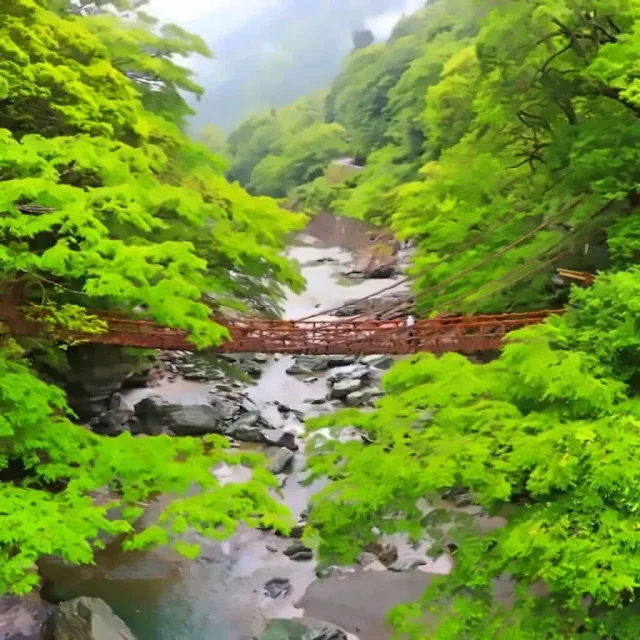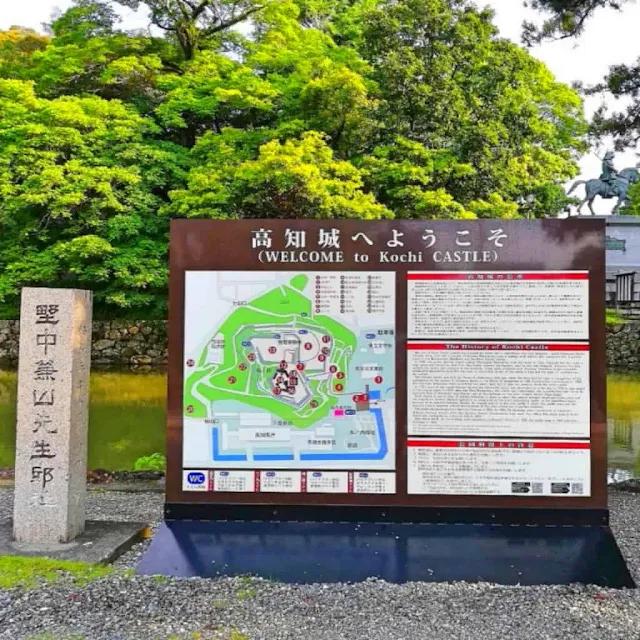Day 1Departure from Umeda: 8:50 AM | Departure from Sannomiya: 9:50 AM
Start your journey with a visit to the Ohnaruto Bridge, which spans approximately 1,629 meters and connects Awaji Island with Tokushima Prefecture. The bridge crosses the turbulent Naruto Strait, and below the roadway, you can find the "Uzushio Path," a seaside promenade. Today’s "high tide" conditions make it an ideal time to witness the impressive whirlpools.
First, enjoy lunch at Udzunoya, and then step outside to find yourself at the Senjojiki Observation Deck, the closest viewpoint to the Ohnaruto Bridge. From here, you can take in the stunning views of the coastline, with the whirlpools and sightseeing boats visible in the strait. Be aware that the return trip to the observation deck involves some uphill and downhill walking, which can be challenging.
Next, travel by bus to Oboke Gorge and Iya Kazura Bridge. The weather turned rainy as you continued your journey, and by the time you arrived at Oboke Gorge, it was pouring rain. Unfortunately, the sightseeing boats on the Yoshino River were canceled due to high water levels, so you missed out on that experience.
The final sightseeing destination for the day is Iya, a region in Tokushima Prefecture. Along with Miyazaki’s Shiba Village and Gifu’s Shirakawa-go, Iya is considered one of Japan’s Three Great Hidden Areas. The Kazura Bridge in Iya is famous for its historical connection to the Heike clan’s tragic tale. Made from Shiramochikazura (weighing about 6 tons), the bridge is 45 meters long, 2 meters wide, and 14 meters above the water. Originally the only transportation route through the deep mountain gorge, it is now a tourist attraction. The bridge is rebuilt every three years and is designated as an Important Tangible Folk Cultural Property. The entrance fee for the Kazura Bridge is 550 yen. Fortunately, the rain eased up, and with fewer visitors, the bridge was not too shaky, allowing you to cross carefully.
Finally, head to your accommodation in Kochi City. On the way to the hotel, you’ll see a small red bridge, which is announced as Kochi’s "Harimaya Bridge," though it was quite different from what you had imagined. For dinner, use a 2000 yen coupon at the Hirome Market, a commercial facility featuring local Kochi cuisine and various food stalls. The market operates as a food village where there are no dedicated tables in the restaurants; instead, you bring your food to the communal tables scattered throughout. You enjoyed seafood dishes and katsuo no tataki (seared bonito) with a beer.
【The Crown Palace New Hankyu Kochi】
Day 2
Since today’s departure is at 8:30 AM, after breakfast we took a stroll around
Kochi Castle, which is very close to the hotel. Kochi Castle, established by the first lord of the Tosa domain,
Yamauchi Kazutoyo, and his wife
Chiyo, is a historic castle with a legacy of
Tosa's 240,000 koku. It is one of the
12 remaining wooden donjons in Japan, and it appears that Kochi Castle is unique in having all the original buildings in the main keep preserved as they were.
Next, we headed to
Katsurahama, one of Kochi Prefecture’s most famous tourist spots, known for its beautiful beach facing the Pacific Ocean. On a small hill at Katsurahama stands a statue of Sakamoto Ryoma, though it was under construction at the time of our visit. Descending to the beach, we enjoyed a panoramic view of Katsurahama, which is often featured on television. On the beach, several people were collecting small stones, including ones in red and green. I wondered if these stones had some special value.
For lunch, we stopped at the Michi-no-Eki Kawasuso-no-Sato Susaki in Susaki City, and then visited the Sada Shinkake Bridge over the clear, tranquil Shimanto River. Shinkake bridges are designed to intentionally sink during floods to prevent damage, a clever solution from past generations. Many of these bridges are still used as local roads and are a notable feature of the Shimanto River.
Afterwards, we traveled to Ryugui Coast, known for its bizarre and unique rock formations, located about 8 kilometers west of Tosa Shimizu City. The area is home to reef-building corals and tropical fish and was designated as Japan’s first underwater park in 1970.
The final destination for the day was Cape Ashizuri, located at the southernmost tip of Shikoku, jutting out into the deep blue Pacific Ocean. In front of the parking lot stands a statue of John Manjiro, who was from the Nakahama area on the west side of Cape Ashizuri. John Manjiro is known for having survived a storm while fishing, being stranded on an uninhabited island, and eventually reaching America, where he contributed to Japan’s internationalization.
【Hotel Ashizuri-en】
Day 3
Today is the final day of our trip. We will drive for over four hours along the Kochi Expressway to reach Kotohira in Kagawa Prefecture, where we will visit the famous Konpira Shrine.
On the way, we stopped at the Umatate Parking Area (upbound) in Shikokuchuo City, Ehime Prefecture, as the bus driver informed us about a limited-edition treat called Kiri-no-Mori Daifuku available at the shop there. Kiri-no-Mori Daifuku is a type of daifuku filled with both sweet red bean paste and fresh cream, all wrapped in matcha-flavored coating. It’s kept frozen and must be naturally thawed before eating, and because it contains fresh cream, it does not keep for long. The package of 8 pieces costs around 1200 yen. I was impressed by how well the matcha and daifuku complemented each other—it was very delicious.
At Konpira Shrine, climbing all the way to the top involves more than 1300 steps, which seemed impractical both in terms of time and physical effort, so we only climbed up to the Daimon at 365 steps before turning back. This concluded our journey through Tokushima and Kochi.


















コメント
No comments :
Post a Comment